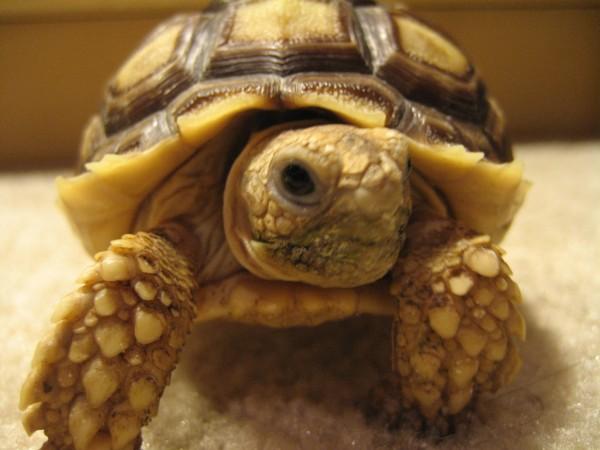| Place of Origin and Range |
The African spurred tortoise, also called the sulcata tortoise, is a species of tortoise, which inhabits the southern edge of the Sahara desert, in northern Africa. The African spurred tortoise is native to the Sahara Desert and the Sahel, a transitional ecoregion of semiarid grasslands, savannas, and thorn shrublands found in the countries of Burkina Faso, Chad, Eritrea, Ethiopia, Mali, Mauritania, Nigeria, Senegal, and Sudan |
| Description |
Adults and babies are tan to pale brown. A narrow head, and the carapace is high domed, but flattened centrally. Sculptured with dark rings around the outside of each dome. This turtle also has oversized scales on its limbs. |
| Morph Patterns Available |
Yes |
| Adult Size |
Can grow up to 2.5 feet(0.8m) |
| Accommodation |
They require large enclosures, temperatures above 60 °F (16 °C), and bedding composed of grasses or grass-based hay. Due to their high dietary fibre needs, grasses form a minimum of 75% of their food intake. |
| Lifespan |
Can live 50+ years |
| Feeding / Diet |
These tortoises are herbivores. Primarily, their diets consist of many types of grasses and plants, high in fibre and very low in protein. Feeding of fruit should be avoided. |
| Breeding |
Copulation takes place right after the rainy season, during the months from September through November. Males combat each other for breeding rights with the females and are vocal during copulation. Sixty days after mating, the female begins to roam looking for suitable nesting sites. For five to fifteen days, four or five nests may be excavated before she selects the perfect location in which the eggs will be laid. |
| Other Considerations |
Watch for theses health concerns carefully with your tortoise. Vitamin A Deficiency: Vitamin A is an important nutrient for your tortoise’s health. It is found in his diet in the form of leafy green, orange or yellow vegetables, liver, and fish. If your tortoise is not getting enough Vitamin A, he can suffer serious health problems. Always check to make sure that your tortoise does not have swollen eyelids, as this is the main sign of a Vitamin A deficiency. Also, check for weight loss, nasal discharge and infected skin. Any of these symptoms could point to a deficiency. If you think your tortoise may not be getting enough Vitamin A, you should take him to the veterinarian to get a firm diagnosis. Shell Problems: Your tortoise's shell is very important to his overall health. There are many potential problems that could occur, so you should be on the lookout at all times. Respiratory Disease: Respiratory infections have symptoms similar to vitamin A deficiency, including swollen eyelids and runny nose, so you should take your tortoise to the veterinarian to get a proper diagnosis if you suspect either. More serious infections will be characterized by breathing through the mouth, mucus in the mouth, and wheezing. Always make sure your tortoise’s environment has the proper amount of humidity, as this will help prevent respiratory problems. |




